2007 MERCEDES-BENZ C-CLASS ESTATE child seat
[x] Cancel search: child seatPage 65 of 377
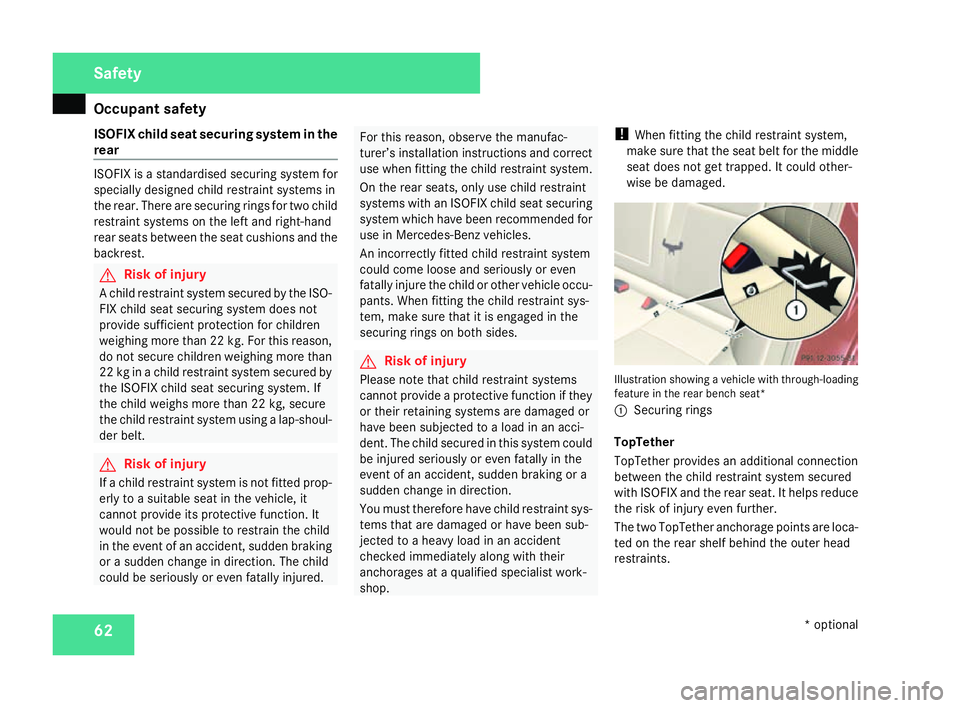
Occupant safet
y62
ISOFIX child seat securing system in the
rea
r ISOFIX is a standardised securing system for
specially designed child restraint systems in
the rear. There are securing rings for two child
restraint systems on the left and right-hand
rear seats between the seat cushions and the
backrest.
G
Risk of injury
A child restraint system secured by the ISO-
FIX child seat securing system does not
provide sufficient protection for children
weighing more than 22 kg. For this reason,
do not secure children weighing more than
22 kg in a child restraint system secured by
the ISOFIX child seat securing system. If
the child weighs more than 22 kg, secure
the child restraint system using a lap-shoul-
der belt. G
Risk of injury
If a child restraint system is not fitted prop-
erly to a suitable seat in the vehicle, it
cannot provide its protective function. It
would not be possible to restrain the child
in the event of an accident, sudden braking
or a sudden change in direction. The child
could be seriously or even fatally injured . For this reason, observe the manufac-
turer’s installation instructions and correct
use when fitting the child restraint system.
On the rear seats, only use child restraint
systems with an ISOFIX child seat securing
system which have been recommended for
use in Mercedes-Benz vehicles .
An incorrectly fitted child restraint system
could come loose and seriously or eve n
fatally injure the child or other vehicle occu-
pants. When fitting the child restraint sys -
tem, make sure that it is engaged in the
securing rings on both sides. G
Risk of injury
Please note that child restraint systems
cannot provide a protective function if they
or their retaining systems are damaged or
have been subjected to a load in an acci -
dent. The child secured in this system could
be injured seriously or even fatally in the
event of an accident, sudden braking or a
sudden change in direction.
You must therefore have child restraint sys-
tems that are damaged or have been sub-
jected to a heavy load in an accident
checked immediately along with their
anchorages at a qualified specialist work-
shop. !
When fitting the child restraint system,
make sure that the seat belt for the middle
seat does not get trapped. It could other-
wise be damaged. Illustration showing a vehicle with through-loading
feature in the rear bench seat*
1
Securing ring s
TopTether
TopTether provides an additional connectio n
between the child restraint system secured
with ISOFIX and the rear seat. It helps reduce
the risk of injury even further.
The two TopTether anchorage points are loca-
ted on the rear shelf behind the outer head
restraints. Safet
y
* optional
204_AKB; 2; 3, en-GB
mkalafa,
2007-06-26T23:11:51+02:00 - Seite 62
Page 66 of 377
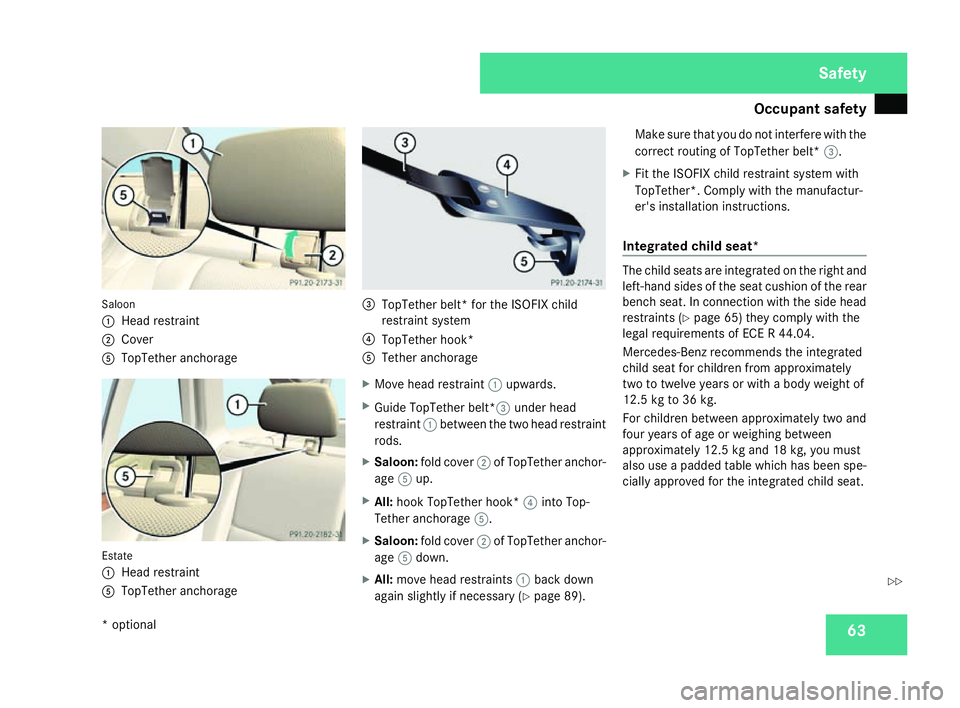
Occupant safet
y 63Saloon
1
Head restraint
2 Cove r
5 TopTether anchorage Estate
1
Head restraint
5 TopTether anchorage 3
TopTether belt* for the ISOFIX child
restraint system
4 TopTether hook*
5 Tether anchorage
X Move head restraint 1upwards.
X Guide TopTether belt *3 under head
restraint 1between the two head restraint
rods.
X Saloon: fold cover 2of TopTether anchor-
age 5up.
X All: hook TopTether hook* 4into Top-
Tether anchorage 5.
X Saloon: fold cover 2of TopTether anchor-
age 5down.
X All: move head restraints 1back down
again slightly if necessary (Y page 89). Make sure that you do not interfere with the
correct routing of TopTether belt*
3.
X Fit the ISOFIX child restraint system with
TopTether*. Comply with the manufactur-
er's installation instructions.
Integrated child seat* The child seats are integrated on the right and
left-hand sides of the seat cushion of the rea
r
bench seat. In connection with the side head
restraints (Y page 65) they comply with the
legal requirements of ECE R 44.04.
Mercedes-Benz recommends the integrated
child seat for children from approximately
two to twelve years or with a body weight of
12.5 kg to 36 kg.
For children between approximately two and
four years of age or weighing between
approximately 12.5 kg and 18 kg, you must
also use a padded table which has been spe-
cially approved for the integrated child seat. Safet
y
* optional
204_AKB; 2; 3, en-GB
mkalafa,
2007-06-26T23:11:51+02:00 - Seite 63 Z
Page 67 of 377
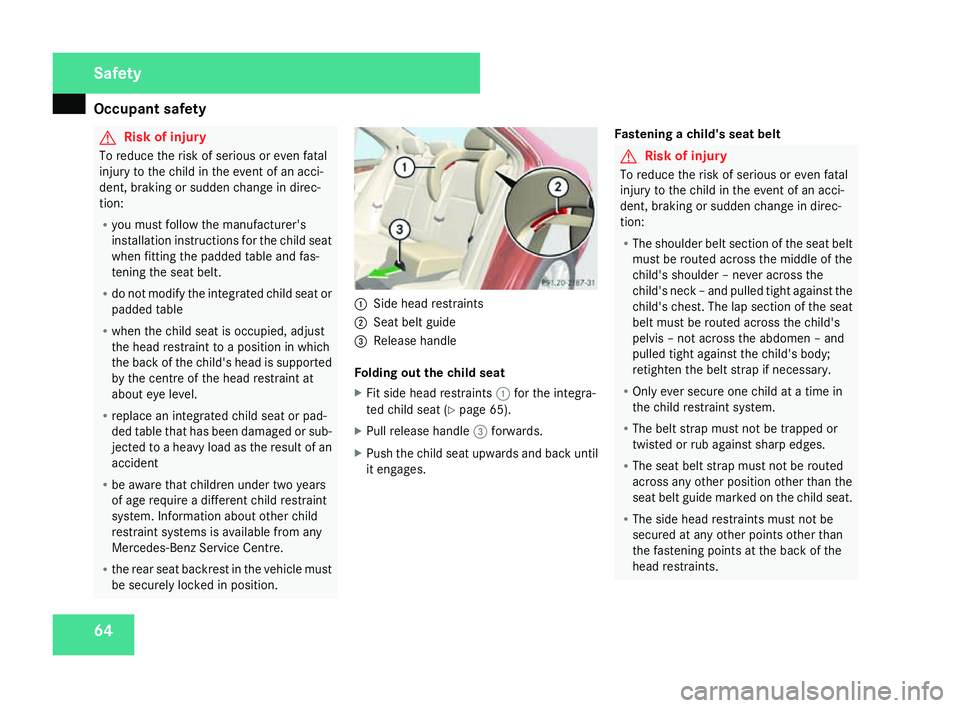
Occupant safet
y64 G
Risk of injury
To reduce the risk of serious or even fata l
injury to the child in the event of an acci-
dent, braking or sudden change in direc -
tion:
R you must follow the manufacturer' s
installation instructions for the child seat
when fitting the padded table and fas-
tening the seat belt.
R do not modify the integrated child seat or
padded table
R when the child seat is occupied, adjus t
the head restraint to a position in which
the back of the child's head is supporte d
by the centre of the head restraint at
about eye level.
R replace an integrated child seat or pad-
ded table that has been damaged or sub-
jected to a heavy load as the result of an
acciden t
R be aware that children under two years
of age require a different child restraint
system. Information about other child
restraint systems is available from any
Mercedes-Benz Service Centre.
R the rear seat backrest in the vehicle must
be securely locked in position. 1
Side head restraints
2 Seat belt guid e
3 Release handle
Folding out the child sea t
X Fit side head restraints 1for the integra -
ted child seat (Y page 65).
X Pull release handle 3forwards.
X Push the child seat upwards and back until
it engages. Fastening a child's seat belt G
Risk of injury
To reduce the risk of serious or even fata l
injury to the child in the event of an acci-
dent, braking or sudden change in direc -
tion:
R The shoulder belt section of the seat belt
must be routed across the middle of the
child's shoulder – never across the
child's neck – and pulled tight against the
child's chest. The lap section of the seat
belt must be routed across the child's
pelvis – not across the abdomen – and
pulled tight against the child's body;
retighten the belt strap if necessary.
R Only ever secure one child at a time in
the child restraint system.
R The belt strap must not be trapped or
twisted or rub against sharp edges.
R The seat belt strap must not be routed
across any other position other than the
seat belt guide marked on the child seat.
R The side head restraints must not be
secured at any other points other than
the fastening points at the back of the
head restraints. Safety
204_AKB; 2; 3, en-GB
mkalafa,
2007-06-26T23:11:51+02:00 - Seite 64
Page 68 of 377

Occupant safet
y 65Also observe the assembly instructions for
the padded table and the additional warn-
ings and information about risk of injury.
X Make sure that the seat belt is routed
through seat belt guides 2on side head
restraints 1.
X Pull the belt smoothly from the belt reel.
X Engage the belt tongue in the buckle .
X If the integrated child seat is being used
without the padded table, make sure that
the belt:
R is routed as low as possible across the
child's pelvic area
R is tightened across the lap by pulling
upwards on the child's shoulder belt
R is routed through seat belt guides 2on
side head restraints 1
R is tight and is routed across the middle of
the child's shoulder
R is not twisted and does not pass across the
child's neck or under the child's arm
X Adjust the head restraint (Y page 89). Folding in the child seat
X
Pull release handle 3forwards.
X Push the child seat back into the seat until
it engages.
X Remove side head restraints 1for the
integrated child seat (Y page 65).
Side head restraints for the integrated
child seat* The side head restraints must be used in con
-
nection with the integrated child sea t
( Y page 63).
i A side head restraint is fitted on vehicles
with integrated child seats*. Should mor e
be required, they can be ordered at any
Mercedes-Benz Service Centre. 1
Lock verification indicator folded out
2 Head restraint
3 Lock verification indicator folded in
4 Release catch
5 Seat belt guid e
6 Side head restraints
Fitting side head restraints G
Risk of injury
For safety reasons, Mercedes-Benz recom-
mends that you only use head restraints
which have been approved by Mercedes-
Benz for your vehicle.
X Slide head restraints 2upwards and posi -
tion them upright. Safety
* optional
204_AKB; 2; 3, en-G
B
mkalafa , 2007-06-26T23:11:51+02:00 - Seite 65 Z
Page 69 of 377
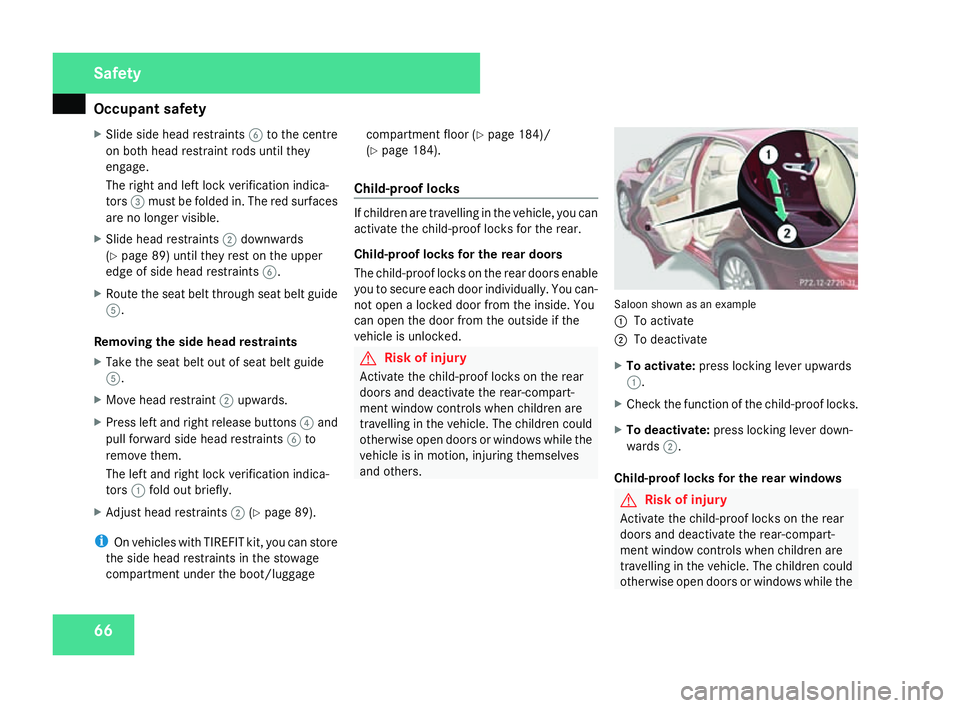
Occupant safet
y66
X
Slide side head restraints 6to the centr e
on both head restraint rods until they
engage.
The right and left lock verification indica-
tors 3must be folded in. The red surfaces
are no longer visible.
X Slide head restraints 2downwards
( Y page 89) until they rest on the upper
edge of side head restraints 6.
X Route the seat belt through seat belt guide
5 .
Removing the side head restraints
X Take the seat belt out of seat belt guide
5 .
X Move head restraint 2upwards.
X Press left and right release buttons 4and
pull forward side head restraints 6to
remove them.
The left and right lock verification indica -
tors 1fold out briefly .
X Adjust head restraints 2(Y page 89).
i On vehicles with TIREFIT kit, you can store
the side head restraints in the stowage
compartment under the boot/luggage compartment floor
(Y page 184)/
( Y page 184).
Child-proof locks If children are travelling in the vehicle, you can
activate the child-proof locks for the rear.
Child-proof locks for the rear doors
The child-proof locks on the rear doors enable
you to secure each door individually. You can-
not open a locked door from the inside. You
can open the door from the outside if the
vehicle is unlocked. G
Risk of injury
Activate the child-proof locks on the rea r
doors and deactivate the rear-compart -
ment window controls when children are
travelling in the vehicle. The children could
otherwise open doors or windows while the
vehicle is in motion, injuring themselve s
and others. Saloon shown as an example
1
To activat e
2 To deactivate
X To activate :press locking lever upwards
1 .
X Check the function of the child-proof locks .
X To deactivate :press locking lever down-
wards 2.
Child-proof locks for the rear windows G
Risk of injury
Activate the child-proof locks on the rea r
doors and deactivate the rear-compart -
ment window controls when children are
travelling in the vehicle. The children could
otherwise open doors or windows while the Safety
204_AKB; 2; 3, en-GB
mkalafa,
2007-06-26T23:11:51+02:00 - Seite 66
Page 89 of 377
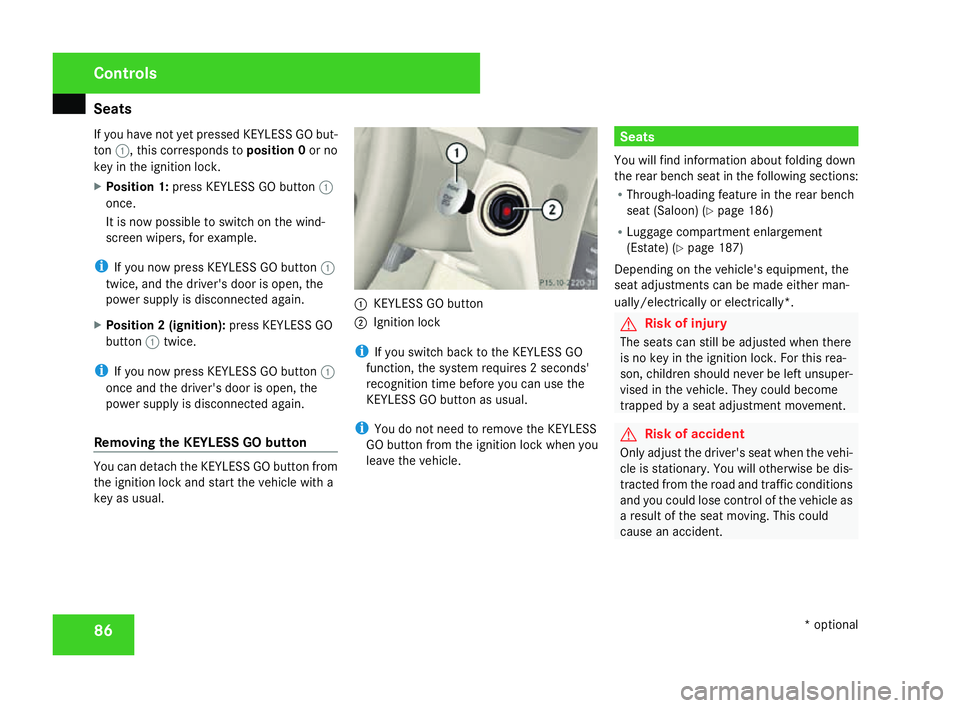
Seats
86
If you have not yet pressed KEYLESS GO but-
ton
1, this corresponds to position0or no
key in the ignition lock.
X Position 1: press KEYLESS GO button 1
once.
It is now possible to switch on the wind-
screen wipers, for example.
i If you now press KEYLESS GO button 1
twice, and the driver's door is open, the
power supply is disconnected again.
X Position 2 (ignition) :press KEYLESS GO
button 1twice.
i If you now press KEYLESS GO button 1
once and the driver's door is open, the
power supply is disconnected again.
Removing the KEYLESS GO button You can detach the KEYLESS GO button from
the ignition lock and start the vehicle with
a
key as usual. 1
KEYLESS GO button
2 Ignition lock
i If you switch back to the KEYLESS GO
function, the system requires 2 seconds'
recognition time before you can use the
KEYLESS GO button as usual.
i You do not need to remove the KEYLESS
GO button from the ignition lock when you
leave the vehicle. Seat
s
You will find information about folding down
the rear bench seat in the following sections :
R Through-loading feature in the rear bench
seat (Saloon) (Y page 186 )
R Luggage compartment enlargement
(Estate) (Y page 187 )
Depending on the vehicle's equipment, the
seat adjustments can be made either man-
ually/electrically or electrically* . G
Risk of injury
The seats can still be adjusted when there
is no key in the ignition lock. For this rea -
son, children should never be left unsuper-
vised in the vehicle. They could become
trapped by a seat adjustment movement. G
Risk of accident
Only adjust the driver's seat when the vehi-
cle is stationary. You will otherwise be dis-
tracted from the road and traffic conditions
and you could lose control of the vehicle as
a result of the seat moving. This could
cause an accident. Control
s
* optional
204_AKB; 2; 3, en-GB
mkalafa,
2007-06-26T23:11:51+02:00 - Seite 86
Page 90 of 377
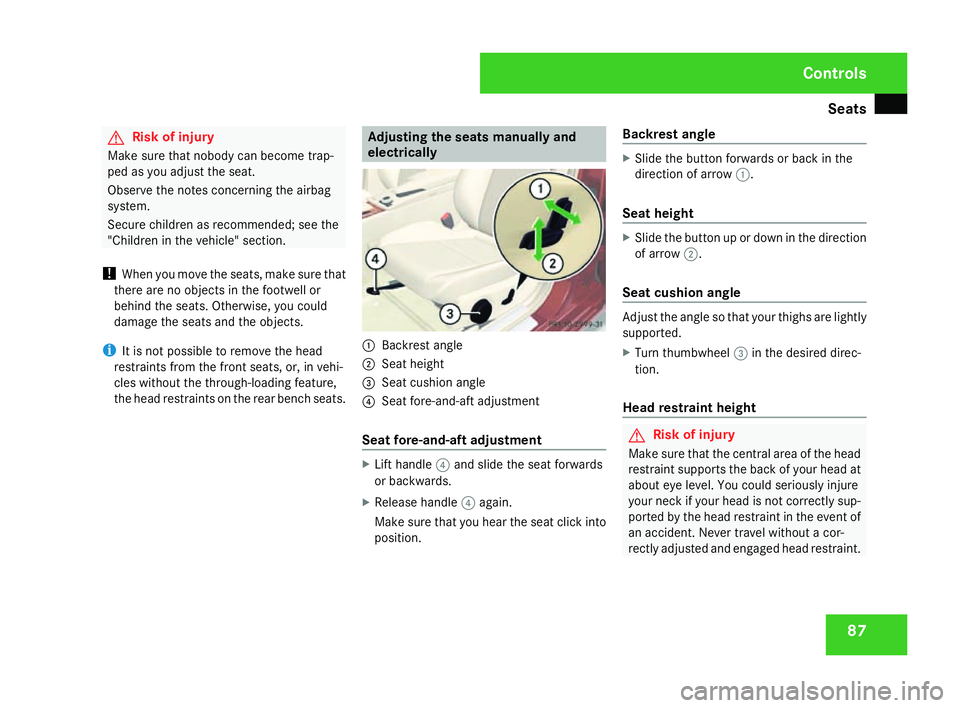
Seats
87G
Risk of injury
Make sure that nobody can become trap -
ped as you adjust the seat.
Observe the notes concerning the airbag
system .
Secure children as recommended; see the
"Children in the vehicle" section.
! When you move the seats, make sure tha t
there are no objects in the footwell or
behind the seats. Otherwise, you could
damage the seats and the objects .
i It is not possible to remove the head
restraints from the front seats, or, in vehi-
cles without the through-loading feature,
the head restraints on the rear bench seats. Adjusting the seats manually and
electricall
y 1
Backrest angl e
2 Seat height
3 Seat cushion angle
4 Seat fore-and-aft adjustment
Seat fore-and-aft adjustment X
Lift handle 4and slide the seat forwards
or backwards .
X Release handle 4again .
Make sure that you hear the seat click into
position. Backrest angle X
Slide the button forwards or back in the
direction of arrow 1.
Seat height X
Slide the button up or down in the direction
of arrow 2.
Seat cushion angle Adjust the angle so that your thighs are lightly
supported.
X Turn thumbwheel 3in the desired direc -
tion.
Head restraint height G
Risk of injury
Make sure that the central area of the hea d
restraint supports the back of your head at
about eye level. You could seriously injure
your neck if your head is not correctly sup-
ported by the head restraint in the event of
an accident. Never travel without a cor-
rectly adjusted and engaged head restraint . Cont
rols
204_AKB; 2; 3, en-GB
mkalafa,
2007-06-26T23:11:51+02:00 - Seite 87
Page 99 of 377
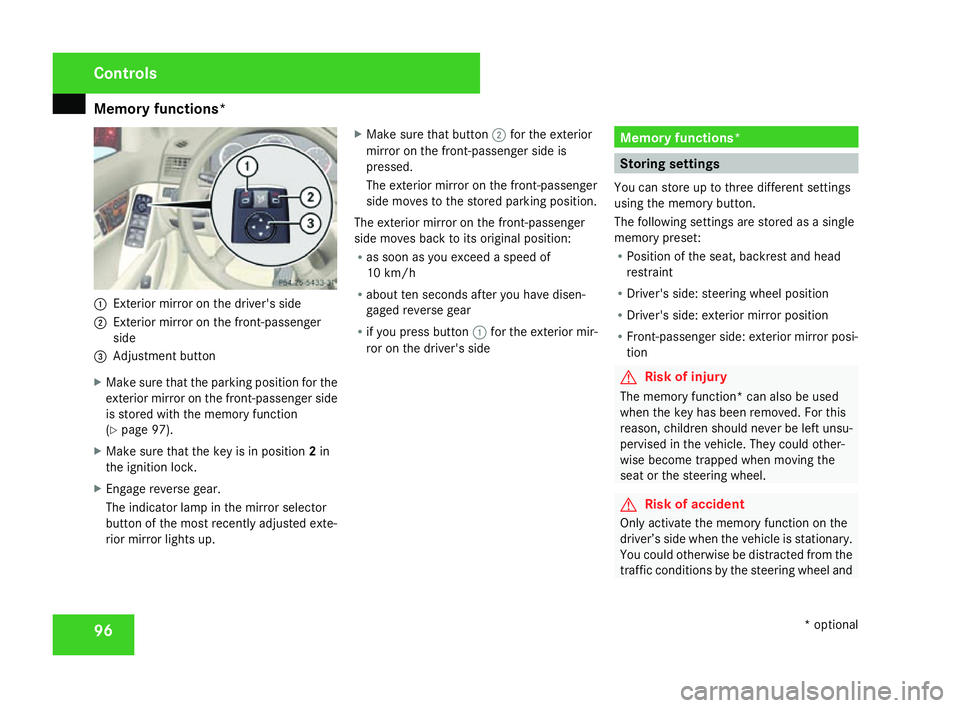
Memory functions*
961
Exterior mirror on the driver's side
2 Exterior mirror on the front-passenge r
side
3 Adjustment button
X Make sure that the parking position for the
exterior mirror on the front-passenger side
is stored with the memory function
( Y page 97).
X Make sure that the key is in position 2in
the ignition lock .
X Engage reverse gear .
The indicator lamp in the mirror selector
button of the most recently adjusted exte-
rior mirror lights up. X
Make sure that button 2for the exterior
mirror on the front-passenger side is
pressed.
The exterior mirror on the front-passenger
side moves to the stored parking position.
The exterior mirror on the front-passenger
side moves back to its original position:
R as soon as you exceed a speed of
10 km/h
R about ten seconds after you have disen -
gaged reverse gear
R if you press button 1for the exterior mir-
ror on the driver's side Memory functions
* Storing settings
You can store up to three different settings
using the memory button.
The following settings are stored as a single
memory preset:
R Position of the seat, backrest and head
restraint
R Driver's side: steering wheel positio n
R Driver's side: exterior mirror positio n
R Front-passenger side: exterior mirror posi-
tion G
Risk of injury
The memory function* can also be used
when the key has been removed. For this
reason, children should never be left unsu-
pervised in the vehicle. They could other-
wise become trapped when moving the
seat or the steering wheel . G
Risk of accident
Only activate the memory function on the
driver’s side when the vehicle is stationary.
You could otherwise be distracted from the
traffic conditions by the steering wheel and Control
s
* optional
204_AKB; 2; 3, en-GB
mkalafa,
2007-06-26T23:11:51+02:00 - Seite 96